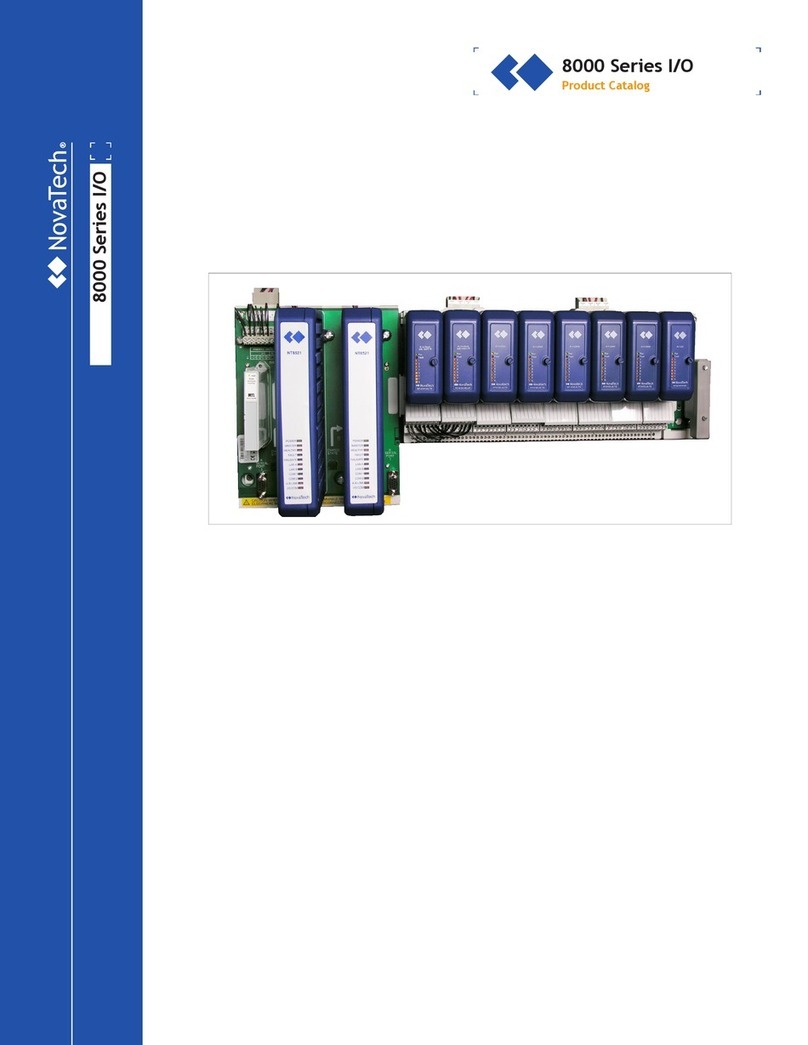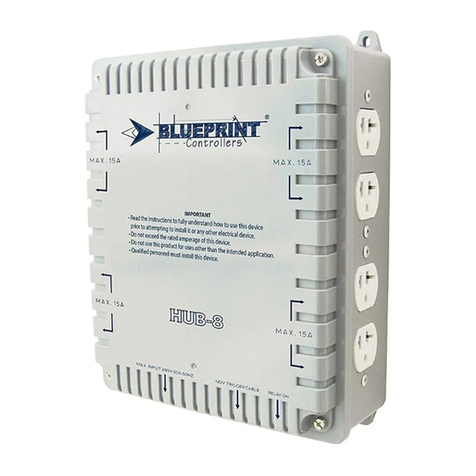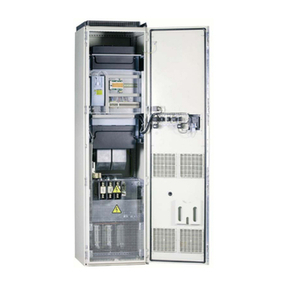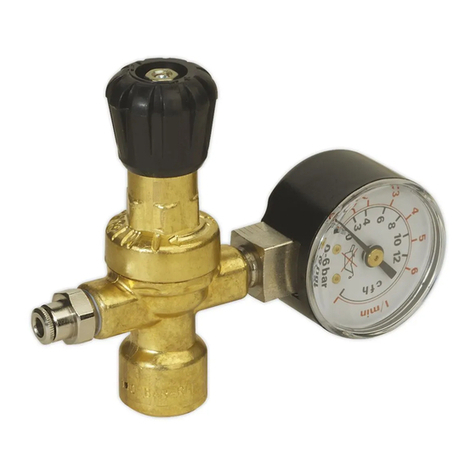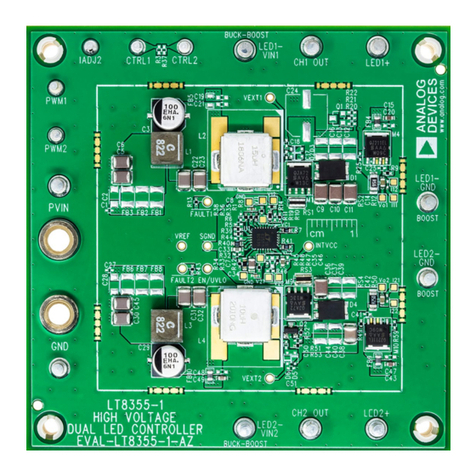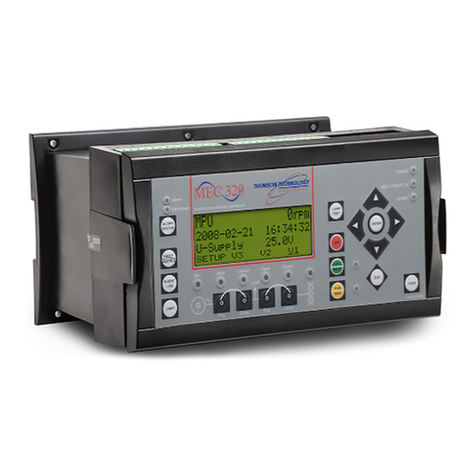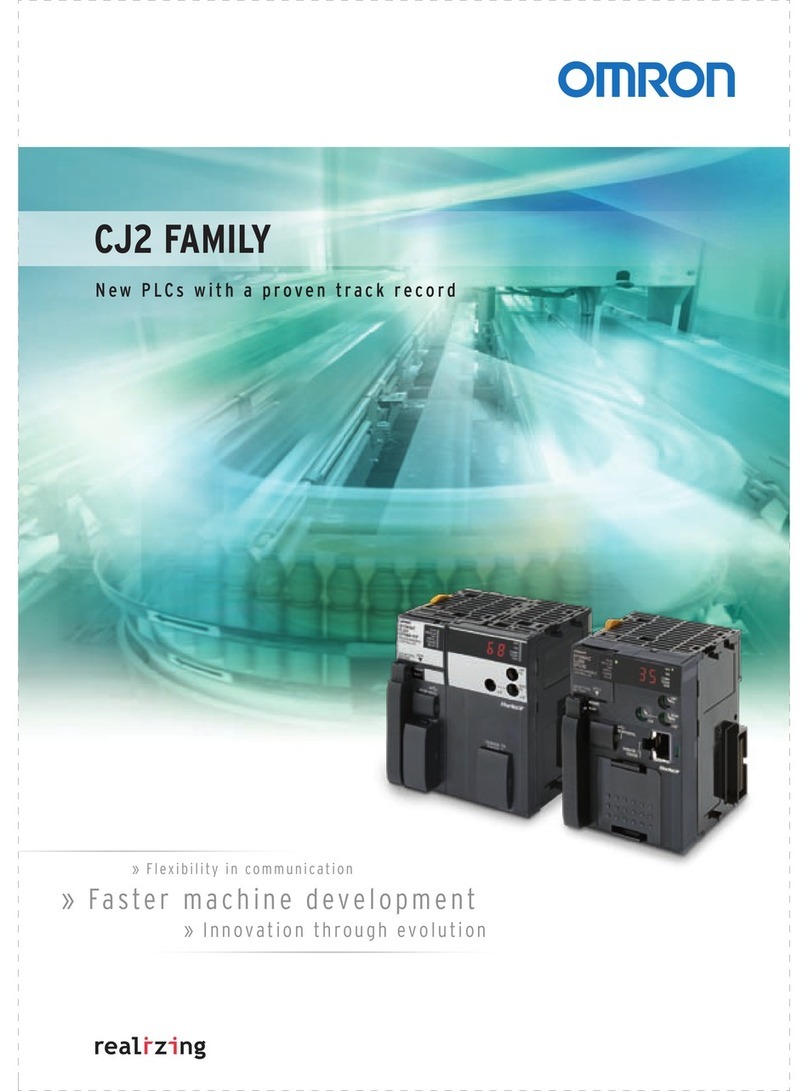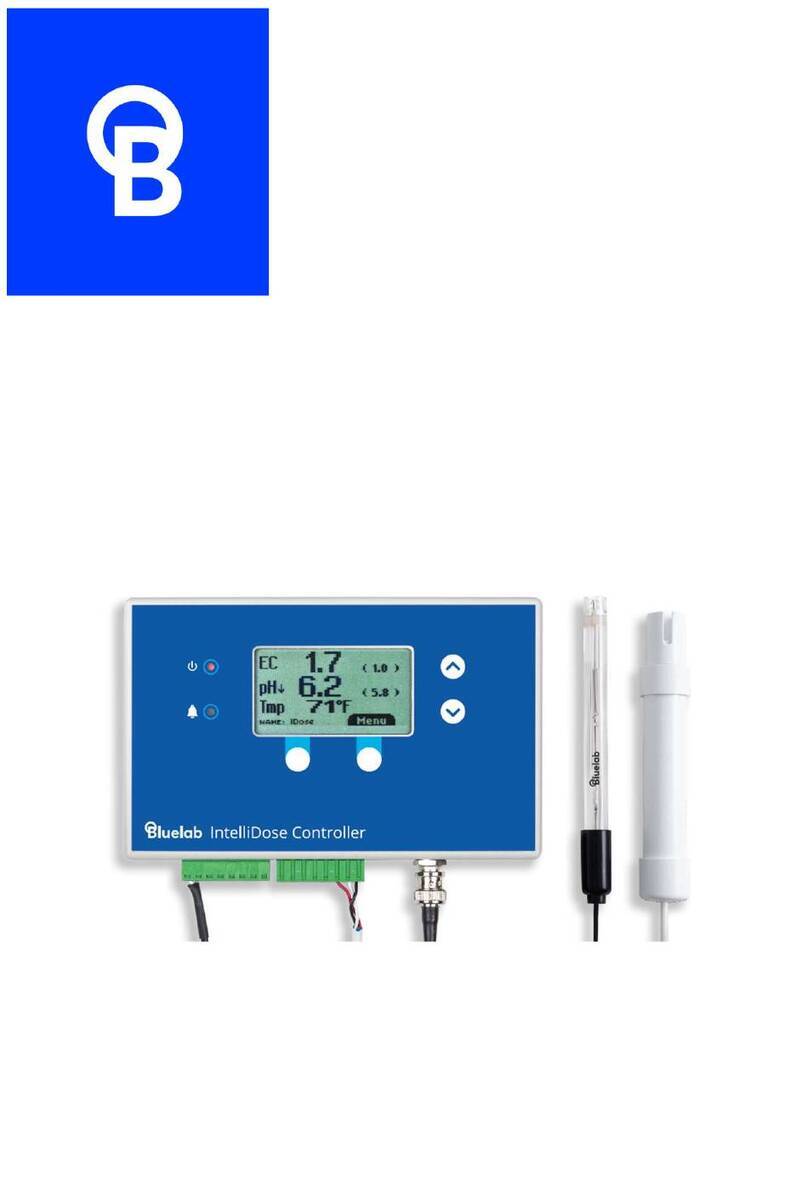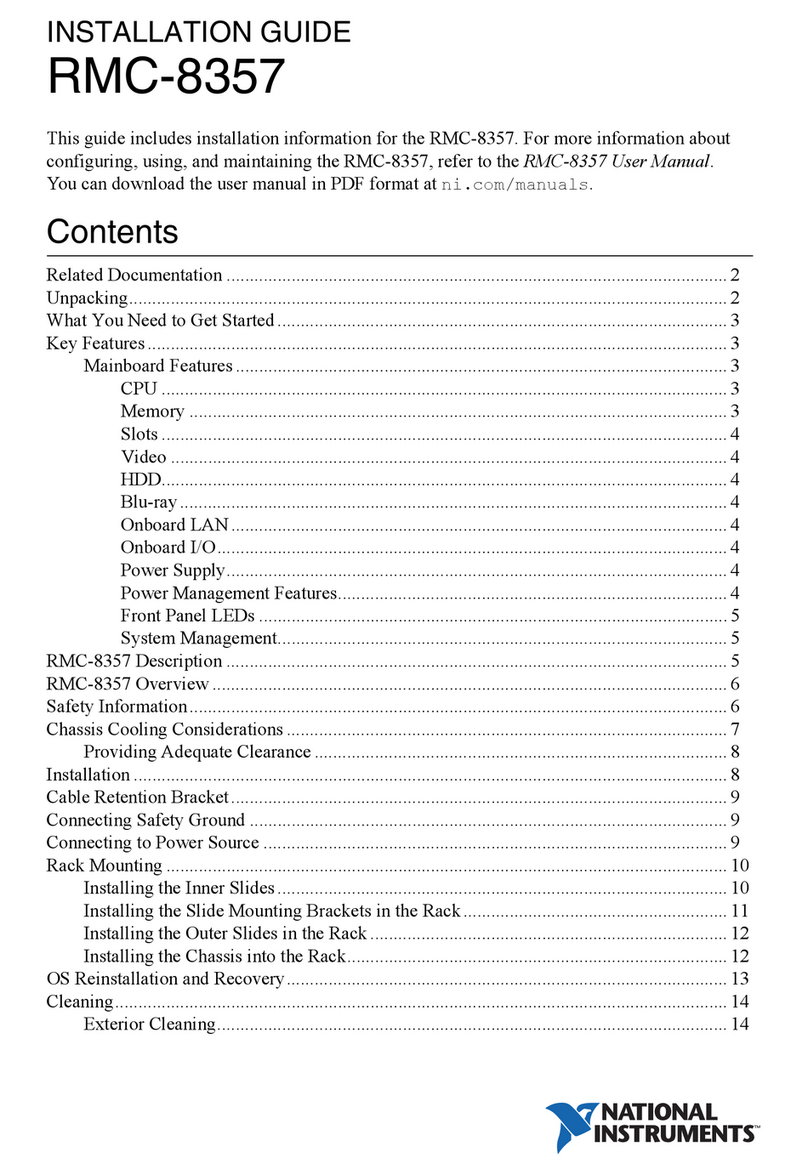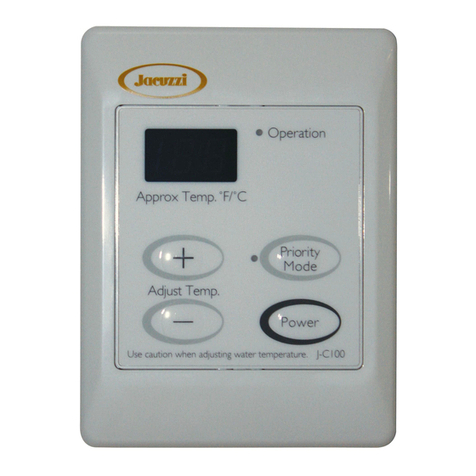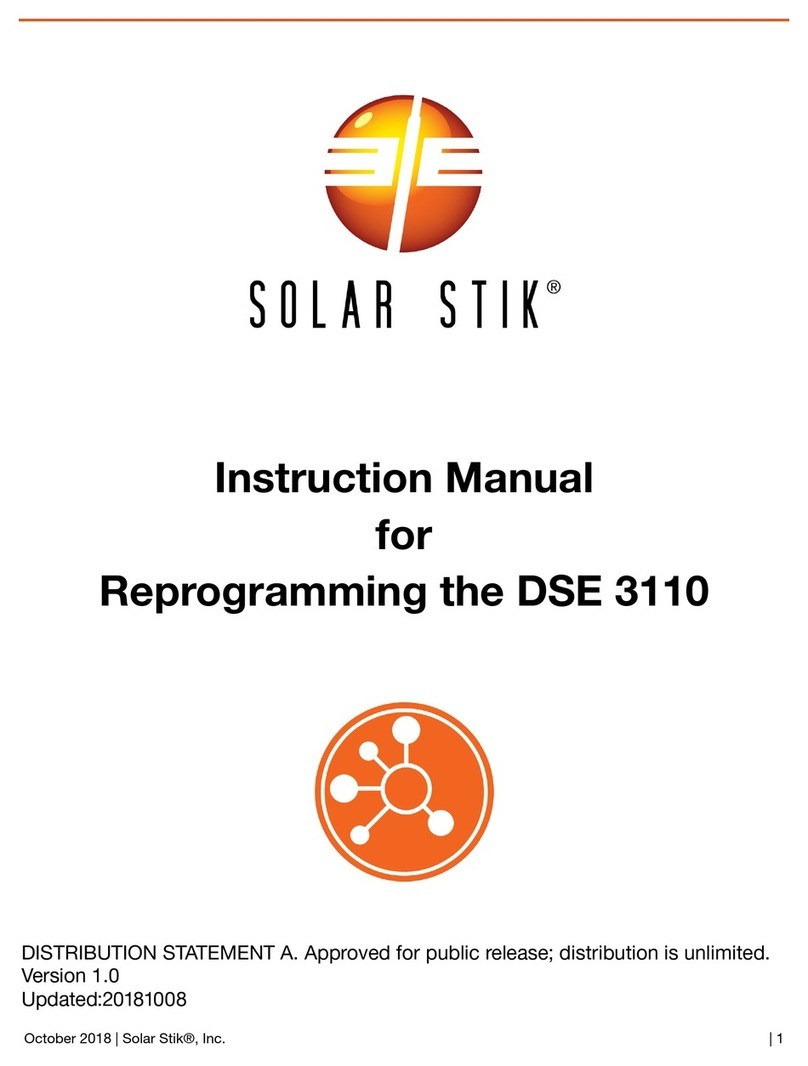Thermal Solutions Boiler Control TSBC User manual

TSBC Instruction Manual Page 1 of 48 102059-01R3-3/20
Thermal Solutions
Boiler Control™
(TSBC™)
Instruction Manual
Contents
Introduction
Quick Reference 2
Overview 4
Product Features
Boiler Sequence 6
Single Boiler Control Mode 9
Multiple Boiler Control Mode 10
EMS Boiler Control Mode 11
Manual Boiler Control Mode 14
Auxiliary Device 15
Front Panel
Features 16
Display Mode 17
Menu Navigation 18
Setpoints Menu 19
Installation
Terminal Layout 20
External Connections 21
Communication 23
Peer-To-Peer Network 25
RS485 Modbus Network 26
Setup & Tuning
Boiler Configuration Menu 28
System Configuration Menu 29
Setup Menu 30
Manual Mode 35
Trouble Shooting
Alarm Messages 36
Diagnostics Menu 38
Sensor Temperature vs. Resistance 41
Security Menu 42
Specifications
General 43
Component Description & Repair Part Numbers 44
Appendix
A. Parameter Summary 45
B. Customer Parameter Worksheet 47
Application
The Thermal Solutions Boiler Control™ (TSBC™) has
been designed for commercial hot water boiler
applications.
Intent
This instruction manual includes detailed functional,
installation and setup information. The intended users
are application engineers, I&O manual and brochure
writers, development and specifying engineers and
installing contractors.
Material from this instruction manual is intended to be
inserted into individual boiler operation manuals,
supervisor instruction manuals, brochures and
promotional and training materials.
IMPORTANT: THESE INSTRUCTIONS SHOULD BE
USED IN CONJUNCTION WITH THE
APPROPRIATE BOILER OR WATER HEATER
INSTALLATION MANUAL.
TSBC™ Front Panel
(Showing Power & Alarm LEDs,
2 Line 16 Character Message Display
and 4 Pushbuttons)

TSBC Instruction Manual Page 2 of 48
Introduction
Quick Reference
CONTROL
MODE
LCD Display
Outlet Sensor
& Local SP
Mode
Remote Sensor
& Local SP Mode
Outlet Sensor &
Remote SP
Mode
Remote Sensor
& Remote SP
Mode
Remote
Control
Mode
Manual
Mode
Typical
Application Single Boiler Multiple Boilers
Energy Management System (EMS) Boiler Control Manual
Operation
Single Boiler
Setpoint Input
Multiple Boilers
Setpoint Input
Modulation
Rate Input
Water Setpoint
Temperature
Sensor Boiler Outlet Remote System Boiler Outlet Remote System Ignored Ignored
Setpoint Operator Operator
Input (C+C-) or
Modbus*
Input (C+C-) or
Modbus* Ignored Ignored
“On” and “Off”
Point Operator Operator Operator Operator Ignored Ignored
Outdoor Air
Reset Option Option Ignored Ignored Ignored Ignored
Domestic Hot
Water Priority
(DHWP)
Option Option Ignored Ignored Ignored Ignored
Warm Weather
Shutdown
(WWSD)
Option Option Option Option Option Ignored
Call For Heat
Call For Heat Based on
Setpoints
Based on
Setpoints
Based on
Setpoints
Based on
Setpoints
Input (RO) or
Modbus Manually Set
Modulation
Rate
Internal Boiler
Control
Based on
Setpoint
Based on
Setpoint
Based on
Setpoint
Based on
Setpoint Ignored Ignored
Lead Boiler
Control
Peer-to-Peer
Connected
With Peer-to-
Peer Connected
With Peer-to-
Peer Connected
With Peer-to-
Peer Connected Ignored Ignored
Remote EMS
Control Ignored Ignored Ignored Ignored
Input (C+C-)
or Modbus Ignored
Manual
Control Ignored Ignored Ignored Ignored Ignored By Operator
Remote
Connections
Local / Remote
Input (LR) Ignored Ignored Closed Closed Closed Ignored
Remote On/Off
(Enable)
Input (RO)
Enable/
Disable
Enable/
Disable
Enable/
Disable
Enable/
Disable On/Off Ignored
Remote Control
Input (C+C-) No No
Remote
Setpoint
Remote
Setpoint
Remote
Modulation Ignored
Communication
Network
Peer-To-Peer
or
Modbus*
Peer-To-Peer
or
Modbus*
Peer-To-Peer
or
Modbus*
Peer-To-Peer
or
Modbus*
Modbus
Only Modbus Only
Additional
Information Page 9 Page 10 Page 11 Page 12 Page 13 Page 14
* If Modbus is selected the Peer-To-Peer Network cannot be used. Modulating Lead/Lag features require the Peer-To-
Peer Network.

TSBC Instruction Manual Page 3 of 48
Introduction
Quick Reference
Abbreviation List
Abbreviation Description
AL Flame Safeguard Alarm
BIT Boiler Inlet Temperature
BOT Boiler Outlet Temperature
BP Boiler Pump
BV Blocked Vent Switch
C Common Termination Point
CA Low Combustion Air Flow
CH Call For Heat (CFH)
CS Fuel Valve Energized
DH Domestic Hot Water Heating Demand
DP Domestic Hot Water Priority (DHWP)
TSBC Sage Boiler Control
EMS Energy Management System
GP High and Low Gas Pressure Switches
HL High Limit Aquastat
HP High Pressure Gas Switch
IN Boiler Inlet Water Temperature
LC Low Water Cutoff Switch
LL Lead Lag
LO Lockout Indicator
LR Local / Remote
M Electric Motor
Mix 3 Way Mixing Valve
OA Outside Air Temperature
OL Operating Limit Aquastat
OO Burner On / Off Switch
OUT Boiler Outlet Water Temperature
RO Remote On / Off
RST Remote System Temperature
SH Space Heating Demand
SI Spare Input (Programmable)
SO Spare Output (Programmable)
SP Setpoint (As found in “Operational SP” and “Remote SP”
SP System Pump
VI Vent Inducer
WF Low Water Flow
WWSD Warm Weather Shutdown
Mixing Valve
Control, (MR, MS)
Description
Termination
Numbers
Termination Number Identification (Typical):

TSBC Instruction Manual Page 4 of 48
Introduction
Overview
Thermal Solutions Boiler Control Overview
The Thermal Solutions Boiler Control (TSBC) is a complete boiler monitoring and automation system. The TSBC provides
advanced boiler modulation, operating control, diagnostics, multiple boiler lead-lag and auxiliary device control. The TSBC
provides advanced control features in an easy to use package.
Flexible, Field Selectable Control
Control modes, water system, boiler auxiliary and
modulating lead/lag control features are menu selectable
without the need for external programmers, laptops or
down loads. Every boiler is shipped with factory defaults
that make field menu selections unnecessary unless you
are applying additional control features.
Boiler Monitoring and Diagnostic Displays
The TSBC’s two line by sixteen character LCD display
may be used for monitoring boiler inlet and outlet,
remote system and outside air temperatures, modulation
rate setpoint and modulating percent and mixing valve
demand percent. Additionally, the display automatically
presents boiler sequence messages, alarms, hold and
lockout messages. A diagnostic menu is included that
provides the last 10 alarm messages and boiler inlet
temperature alarm history. Boiler inlet temperature
alarm history includes time and date, the lowest inlet
temperature reached and the amount of time the water
temperature dropped below the alarm setpoint.
Modulation Rate and On/Off Modes
The TSBC may simply control boiler modulation and
on/off output based on the boiler water outlet
temperature and an operator adjusted setpoint.
However, using parameter selections, the TSBC allows
the boiler modulation and on/off output to respond to
remote system water and outside air temperatures,
Domestic Hot Water Priority (DHWP) input or Energy
Management System (EMS) modulation rate demand,
remote setpoint or remote start/stop commands.
Parameter selections of remote system water
temperature and remote mode determine the choice of
one of six different control modes.
Advanced Availability
The above control modes are menu selectable options.
However, if a selected sensor fails, the TSBC
automatically changes to a control mode that will allow
continued automatic operation of the boiler. For
example, in the event of a remote system temperature
sensor failure, the TSBC will automatically switch to
boiler outlet temperature sensor based control.
Outdoor Air Reset
When selected the modulation rate setpoint is
automatically adjusted based on outside air temperature.
Outdoor air “reset” setpoint saves fuel by adjusting the
water temperature of a heating boiler lower as the
outside air temperature increases.
Warm Weather Shutdown (WWSD)
Some boilers are used primarily for heating buildings,
and the boilers can be automatically shutdown when the
outdoor air temperature is warm. When outside air
temperature is above the WWSD setpoint, this function
will prevent the boiler, boiler pump and/or the system
pump from starting.
Domestic Hot Water Priority (DHWP)
Some boilers are used primarily for building space
heating, but also provide heat for the domestic hot water
users. When the outdoor temperature is warm, the
outdoor reset setpoint may drop lower than a desirable
domestic hot water temperature. When enabled and a
DHWP contact input is detected, the hot water setpoint
is adjusted to be greater than a field adjustable DHWP
Setpoint.
Water Side Control Outputs
In order to maximize the life and availability of a hot
water systems it may be desirable to automate mixing
valves, boiler pumps, system pumps, and standby
system pumps. The TSBC makes this type of
automation totally integrated and cost effective. The
control of these devices is field selectable through
simple yes/no menu selections.
Combustion Air Side Control Outputs
Boiler room Combustion air dampers (fresh air dampers)
and Vent Inducer control outputs are field selectable
options.
Peer-To-Peer Network
The TSBC includes state-of-the-art modulating lead-lag
sequencer for up to eight (8) boilers capable of auto
rotation, outdoor reset and peer-to-peer communication.
The peer-peer network is truly “plug and play”.
Communication is activated by simply connecting a
RJ11 telephone line between boilers. The TSBC
provides precise boiler coordination by sequencing
boilers based on both remote system water temperature
and boiler modulation rate. For example, the lead boiler
can be configured to start a lag boiler after operating
above 90% modulation rate for longer than an adjustable
time. The boilers are modulated in “unison” (parallel)
modulation rate to ensure even heat distribution
Modbus Communication Interface
A factory configured RS485 Modbus interface is
available for Energy Management System (EMS) or
SCADA system monitoring and control. Modbus is not
available when using Peer-to-Peer.

TSBC Instruction Manual Page 5 of 48
Introduction
Overview
Thermal Solutions Boiler Control

TSBC Instruction Manual Page 6 of 48
Product Features
Boiler Sequence
Notes
a. Boiler Pump is “On” when the Boiler Pump is set to “On Always” or the boiler is lead boiler and Boiler Pump is set to “On Lead”.
b. Boiler Pump is "On" when the Boiler Pump is set to "On Always" and WWSD is set to "WWSD of System Pump" or “Off”.
c. System Pump is "On" when the System Pump is set to “yes” and WWSD is set to either "WWSD of Boiler" or "Off".
d. Boiler pump is "On" during Prepurge and Post Purge when Boiler Pump is set to "Purge" or boiler is lead & Boiler Pump is set to “On Lead”.
e. Combustion Air Damper Spare Output is maintained “On” for 2 minutes after the Call For Heat is removed.
f. Modulation rate is held at purge % when low fire input is not provided.
g. When using the spare output for a Combustion Air Damper, Jumper from SO to BP and set Boiler Pump to “Purge”.

TSBC Instruction Manual Page 7 of 48
Product Features
Boiler Sequence (Continued)
Pre-Sequence States
BOILER
STATE
LCD Display
CONTROL MODE
LCD Display Description
Boiler
Disabled
Any Mode
(Except for
Remote Control)
Boiler is prevented from starting, Remote On/Off (Enable) (Terminal RO) Input is not
energized.
Warm
Weather
Shutdown
Any Mode
(Except for
Manual Mode)
Boiler is prevented from starting, Warm Weather Shutdown (WWSD) is enabled and
outside air temperature is above the WWSD Setpoint.
Lockout Any Mode
Boiler is prevented from starting, Flame Safeguard lockout is present. A Flame
Safeguard manual reset is required.
Standby
Outlet Sensor &
Local SP Mode
Control monitors boiler outlet temperature, a Call For Heat is initiated when boiler
outlet temperature is below the Operational Setpoint.
Remote Sensor
& Local SP
Mode
Control monitors Remote System Temperature, a Call For Heat is initiated when
Remote System Temperature is below the Operational Setpoint.
Outlet Sensor &
Remote SP
Mode
Control monitors boiler outlet temperature, a Call For Heat is initiated when boiler
outlet temperature is below the Remote Setpoint Input (Terminal C+,C- or Modbus
Interface).
Remote Sensor
& Remote SP
Mode
Control monitors Remote System Temperature, a Call For Heat is initiated when
Remote System Temperature is below the Remote Setpoint Input (terminal C+,C- or
Modbus Interface).
Remote Control
Mode
Control monitors Remote On/Off (Enable) input (Terminal RO or Modbus Interface), a
Call For Heat is initiated when input is energized.
Manual
Operation Mode A Call For Heat is initiated when Manual Mode Menu item Boiler On/Off is set to On.
Start/Stop Sequence States
BOILER
STATE
LCD Display
CONTROL MODE
LCD Display Description
Pump Purge
Any Mode
(Except
Manual Mode)
Once a Call For Heat is initiated and Boiler Pump Purge is selected, the pump output
is energized until the Pump Prepurge Time is complete. If the Call For Heat condition
still exists at the end of the Prepurge Time (the temperature of the water at the sensor
may rise with boiler water flowing passed it) the pump will continue to operate and the
Call For Heat Relay is energized.
Limit Hold Any Mode
Power is applied to the safety limit string. If any limits does not pass power (is not
energized), the alarm LED and LCD display shows the reason the start sequence is
on Hold. Refer to Trouble shooting section for explanation of individual lockout and
alarm messages.
Purge / Pilot
Ignition Any Mode
After the limit string passes power, the fan is started, the modulation output is set to
Purge Rate. When the purge period is complete, the flame safeguard sequences on
the ignition transformer and pilot.
Low Fire /
Ignition Any Mode When the Spare Input Low Fire is selected, modulation output is set to the Low Fire
Speed when the Spare Input is energized.
Main Ignition Any Mode The main gas valve input is energized and the modulation output is held constant for
an ignition stabilization period.
Low Fire
Hold Any Mode The modulation output is held at the Low Fire for the Low Fire Hold time.
Boiler
Running Any Mode When this Low Fire Hold time is complete, the modulation output is released to
modulate.
Fan Post
Purge Any Mode
When water temperature is above setpoint, there is a Flame Safeguard or Limit fault,
the Call For Heat is ended and the modulating output is set to Purge Rate for the Post
Purge Time.
Pump
Cooldown Any Mode
When Boiler Pump Purge is selected, the boiler pump remains “on” until the boiler
outlet temperature is less than the Post Purge Delta (default is 5 F) above the Boiler
Inlet Temperature.

TSBC Instruction Manual Page 8 of 48
Product Features
Boiler Sequence (Continued)
Multiple Boilers
Boiler Start and Stop Peer-To-Peer Network Sequence Diagram
(3 boiler system shown, typical for up to 8 boilers)
-Lead Boiler Start
Water temperature is below the setpoint by more than the “On Point” differential.
-Temperature Based Lag Boiler Start
Water temperature is below the setpoint by more than the “On Point” differential for longer than the adjustable
time delay (“Boiler On Delay” parameter).
-Modulation % Based Lag Boiler Start
The boiler modulation rate has been above the adjustable limit (“LL Start Trigger” parameter) for longer than the
time delay.
-Lag Boiler Stop
The boiler modulation rate has been below the adjustable limit (“LL Stop Trigger” parameter) for longer than the
time delay. Additionally, lag boilers are stopped when water temperature is above the setpoint by more than the
“Off Point” differential for longer than the “Boiler Off Delay” parameter).
-Lead Boiler Stop
The last boiler remains on line until the water temperature is above the “Off Point” setpoint for longer than the
time delay.
Notes
-The “Boiler Address” parameter assignment determines the boiler sequencing order.
-The Lead Boiler automatically rotates (when “Rotate” parameter is enabled) based on field adjusted time
(“Rotate After” parameter, default is 168 hours). When rotating, the lead boiler will move to the end of the lag
order and the 1st lag boiler will become the lead. The rest of the boilers will then move up in the lag order
accordingly.
-Lead Boiler is the first boiler to turn on and the last boiler to turn off, (First On, Last Off, FOLO).
-Lag Boilers are turned on in order and turned off in reverse order, (First On, Last Off, FOLO).
-Tripped boilers are replaced without waiting for the Boiler On Delay timer. If a tripped boiler becomes available it
is returned to service.
1
3
4
2
5

TSBC Instruction Manual Page 9 of 48
Product Features
Single Boiler Control
Display Shows: Outlet Sensor & Local SP Mode
Boiler Outlet
Temperature
(
BO
,
BC
)
Boiler Inlet
Temperature
(
BI
,
BC
)
RJ
11
,
RS
-
485
Communication
Peer
-
To
-
Peer Network
for Modulating Lead
/
Lag
Or
Modbus Network
for Touch Screen or EMS Monitoring
Return
Water
Outside Air
Temperature
(
O
+
,
O
-
)Boiler
Circulator
System
Circulator
EMS System Hardwired Connections
Lockout Indicator
(
LO
)
Soft Alarm
(
SO
)
Remote On
/
Off
(
Enable
) (
RO
)
DHW
Override
Switch
(
DP
)
System
Supply Water
Domestic Hot
Water
(
DHW
)
Supply
POWER
Outlet Sensor & Local SP Mode Application Diagram
(Showing Relevant Connections)
Features
Setpoints
The operator selects the setpoint and on and off points
from the LCD display.
Modulation Rate Control
Boiler automatically modulates to maintain the boiler
outlet temperature at setpoint.
Call for Heat
The Call For Heat is determined by the setpoint, on
and off points and boiler outlet temperature.
Options
Outside Air Reset
If enabled, the Outside Air Sensor will automatically
adjusted the setpoint.
Warm Weather Shutdown (WWSD)
If enabled, the WWSD will disable a boiler start when
outside air temperature is above a Warm Weather
Shutdown (WWSD) setpoint.
Domestic Hot Water Priority (DHWP)
If enabled, the DHWP will adjust the setpoint to satisfy
the DHWP setpoint when a DHWP input (DP) is
energized.
Selecting This Control Mode
To select Outlet Sensor & Local SP Mode set the following
parameters:
System Configuration Menu:
Remote Control = “No”
Remote System Temperature Sensor = “No”
Remote On / Off (Enable) Input (RO) = Closed (Jumper (RO)
to (C) )
If the Remote On / Off (Enable) (RO) input is opened, the Call
For Heat Relay (CH) is de-energized.
Modbus Network
To establish a Modbus network set the following parameters:
Communication Menu:
Protocol = Modbus
Modbus Address = Give each boiler a unique address.
Baud Rate = Set identical to remote system.
Parity = Set identical to remote system.
Connect all boilers using a RJ11 ended telephone cable.
If the Modbus network is activated the remote system may
monitor and/or control boiler operation. Refer to page 26 for
additional information.

TSBC Instruction Manual Page 10 of 48
Product Features
Multiple Boiler Control
Display Shows: Remote Sensor & Local SP Mode
Domestic Hot
Water Priority
(
DP
)
DHW Override
Switch
(
DP
)
System
Supply Water
Return
Water
Connects to
Up to Eight
Boilers
RJ
11
,
RS
485
Peer to Peer
Network
Remote System
Temperature
(
R
+
,
R
-
)
Outside Air
Temperature
(
O
+
,
O
-
)Boiler
Circulator
System
Circulator
Boiler
Circulator Boiler
Circulator Remote System
Temperature
(
R
+
,
R
-
)
EMS System Hardwired
Connections
Lockout Indicator
(
LO
)
Soft Alarm
(
SO
)
Remote On
/
Off
(
Enable
) (
RO
)
Wired to Each
TSBC controller
Domestic Hot Water
(
DHW
)
Supply
Outside Air
Temperature
(
O
+
,
O
-
)
Boiler Outlet
Temperature
(
BO
,
BC
)
Boiler Inlet
Temperature
(
BI
,
BC
)
Boiler Running
ALAR M
POWER
Boiler Running
ALAR M
POWER
Boiler Running
ALAR M
POWER
Remote Sensor & Local SP Mode Application Diagram
(Showing relevant connections for 3 boilers, typical for up to 8)
Features
Setpoints
The operator selects the setpoint and on and off points
from the LCD display.
Modulation Rate Control
Boiler automatically modulates to maintain the Remote
System Temperature (RST) at setpoint.
Call for Heat
The Call for Heat is determined by setpoint, on and off
points and RST. If a Peer-To-Peer network is activated, a
Call for Heat is also initiated when the Lead boiler
modulation rate % is above an adjustable High Fire Rate
Limit (parameter 37) for too long a time.
Options
Outside Air Reset
If enabled, the Outside Air Sensor will automatically
adjusted the setpoint.
Warm Weather Shutdown (WWSD)
If enabled, the WWSD will disable a boiler start when
temperature is above a Warm Weather Shutdown (WWSD)
setpoint.
Domestic Hot Water Priority (DHWP)
If enabled, the DHWP will adjust the setpoint to satisfy the
DHWP setpoint when a DHWP contact input (DP) is
closed. When multiple boilers monitor the DHWP input, an
isolated contact is required for each boiler.
Selecting This Control Mode
To select Remote Sensor & Local SP Mode set the
following parameters:
System Configuration Menu:
Remote Control = “No”
Remote System Temperature Sensor = Control
Remote On / Off (Enable) Input (RO) = Closed (Jumper
(RO) to (C) )
If the Remote On / Off (Enable) (RO) input is opened, the
Call For Heat Relay (CH) is de-energized.
If the Remote System Temperature Sensor (RST) fails, the
control mode is automatically switched to Outlet Sensor &
Local SP Mode.
Peer-To-Peer Network
To establish a Peer-To-Peer network follow the procedure
provided on page 25.
If the Peer-To-Peer network is activated the Lead boiler
controls modulation rate and Call for Heat for all networked
boilers. Up to 8 networked boilers are fired in “Unison” (all
at the same modulation rate).

TSBC Instruction Manual Page 11 of 48
Product Features
Energy Management System (EMS) Boiler Control
Display Shows: Outlet Sensor & Remote SP Mode
RJ
11
,
RS
-
485
Communication
Peer
-
To
-
Peer Network
for Modulating Lead
/
Lag
Or
Modbus Network
for Touch Screen or EMS Monitoring
EMS System
Hardwired Connections
Lockout Indicator
(
LO
)
Soft Alarm
(
SO
)
Remote On
/
Off
(
Enable
) (
RO
)
Remote Setpoint
(
C
+
,
C
-
)
Boiler Outlet
Temperature
(BO, BC)
Boiler Inlet
Temperature
(BI, BC)
Return
Water
Outside Air
Temperature
(O+, O-)Boiler
Circulator
System
Circulator
DHW
Override
Switch (DP)
System
Supply Water
Domestic Hot
Water (DHW)
Supply
ALAR M
POWER
Outlet Sensor & Remote SP Mode Application Diagram
(Showing relevant connections)
Features
Setpoints
The setpoint is determined by the Remote Input (C+,C-)
or Modbus Input and operator sets the on and off points
from the LCD display.
Modulation Rate Control
Boiler automatically modulates to maintain the boiler
outlet temperature at setpoint.
Call for Heat
The Call For Heat is determined by setpoint, on and off
points and boiler outlet temperature.
Options
Warm Weather Shutdown (WWSD)
If enabled, the WWSD will disable a boiler start when
temperature is above a Warm Weather Shutdown
(WWSD) setpoint.
Outside Air Temperature may be displayed only.
Outside Air Reset and Domestic Hot Water Priority input
(DP) are ignored.
Selecting This Control Mode
To select Outlet Sensor & Remote SP Mode set the following
parameters:
System Configuration Menu:
Remote Control = “Remote SP”
Remote System Temperature Sensor = “No”
Local / Remote Input (LR) = Closed
Remote On / Off (Enable) Input (RO) = Closed (Jumper (RO)
to (C) )
When the Local / Remote Input (LR) is open, Remote Input
(C+,C-) is ignored and Outlet Sensor & Local SP Mode is
active.
If the Remote On / Off (Enable) (RO) input is opened, the
Call For Heat Relay (CH) is de-energized.
Modbus Network
To establish a Modbus network set the following parameters:
Communication Menu:
Protocol = Modbus
Modbus Address = Give each boiler a unique address.
Baud Rate = Set identical to remote system.
Parity = Set identical to remote system.
Connect all boilers using a RJ11 ended telephone cable.
If the Modbus network is activated the remote system may
monitor and/or control boiler operation. Refer to page 26 for
additional information.

TSBC Instruction Manual Page 12 of 48
Product Features
Energy Management System (EMS) Boiler Control (continued)
Display Shows: Remote Sensor & Remote SP Mode
EMS System Connections
Lockout Indicator (LO)
Soft Alarm (SO)
Remote On / Off (Enable) (RO)
Remote Setpoint (C+,C-)
System
Supply Water
Return
Water
Connects to
Up to Eight
Boilers
RJ11, RS 485
Peer to Peer
Network
Remote System
Temperature
(R+,R-)
Outside Air
Temperature
(O+, O-)Boiler
Circulator
System
Circulator
Boiler
Circulator Boiler
Circulator Remote System
Temperature
(R+,R-)
Wired to Each
TSBC Controller
Outside Air
Temperature
(O+, O-)
Boiler Outlet
Temperature
(BO, BC)
Boiler Inlet
Temperature
(BI, BC)
ALAR M
POWER AL AR M
POWER
ALAR M
POWER
Remote Sensor & Remote SP Mode Application Diagram
(Showing relevant connections for 3 boilers, typical for up to 8)
Features
Setpoints
The setpoint is determined by the Remote Input (C+,C-)
and operator sets the on and off points from the LCD
display.
Modulation Rate Control
Boiler automatically modulates to maintain the Remote
System Temperature (RST) at setpoint.
Call for Heat
The Call For Heat is determined by setpoint, on and off
points and Remote System Temperature. If a Peer-To-
Peer network is activated, a Call for Heat is also initiated
when the Lead boiler modulation rate % is above an
adjustable High Fire Rate Limit (Parameter 37) for too
long a time.
Options
Warm Weather Shutdown (WWSD)
If enabled, the WWSD will disable a boiler start when
temperature is above a Warm Weather Shutdown
(WWSD) setpoint.
Outside Air Reset and Domestic Hot Water Priority input
(DP) are ignored.
Selecting This Control Mode
To select Remote Sensor & Remote SP Mode set the
following parameters:
System Configuration Menu:
Remote Control = “Remote SP”
Remote System Temperature Sensor = Control
Local / Remote Input (LR) = Closed (Jumper (LR) to (C) )
Remote On / Off (Enable) Input (RO) = Closed (Jumper (LR)
to (C) )
When the Local / Remote Input (LR) is open, Remote Input
(C+,C-) is ignored and Remote Sensor & Local SP Mode is
active.
If the Remote On / Off (Enable) (RO) input is opened, the
Call For Heat Relay (CH) is de-energized.
Peer-To-Peer Network
To establish a Peer-To-Peer network follow the procedure
provided on page 25.
If the Peer-To-Peer network is activated the Lead boiler
controls modulation rate and Call for Heat for all networked
boilers. Up to 8 networked boilers are fired in “Unison” (all
at the same modulation rate).

TSBC Instruction Manual Page 13 of 48
Product Features
Energy Management System (EMS) Boiler Control (continued)
Display Shows: Remote Control Mode
RJ
11
,
RS
-
485
Communication
Modbus Network
EMS Monitoring and Control
Remote Firing Rate via Modbus
Remote on/off via Modbus
EMS System
Hardwired Connections
Lockout Indicator (LO)
Soft Alarm(SO)
Remote On/ Off (Enable) (RO)
Remote Setpoint (C+,C-)
Boiler Outlet
Temperature
(
BO
,
BC
)
Boiler Inlet
Temperature
(
BI
,
BC
)
Return
Water
Boiler
Circulator
System
Circulator
System
Supply Water
ALAR M
POWER
Remote Control Mode Application Diagram
(Showing relevant connections)
Features
Modulation Rate Control
The Remote Input (C+,C-) or Modbus input sets
modulation rate. The setpoint is ignored.
Call for Heat
The Call For Heat is determined by Remote On/Off
input (RO) or Modbus input. The on and off points are
ignored. The boiler will turn off if the water
temperature increases past the temperature set on the
Operational Temperature Limit.
Options
Outside Air Reset and Domestic Hot Water Priority
input (DP) and Warm Weather Shutdown are ignored.
Selecting This Control Mode
To select Remote Control Mode set the following parameters:
System Configuration Menu:
Remote Control = “Remote Mod”
Remote System Temperature Sensor = Display Only
Local / Remote Input (LR) = Closed (Jumper (LR) to (C) )
When the Local / Remote Input (LR) is open, Remote Input
(C+,C-) is ignored and Remote Sensor & Local SP Mode is
active.
Modbus Network
To establish a Modbus network set the following parameters:
Communication Menu:
Protocol = Modbus
Modbus Address = Give each boiler a unique address.
Baud Rate = Set identical to remote system.
Parity = Set identical to remote system.
Connect all boilers using a RJ11 ended telephone cable.
If the Modbus network is activated the remote system may
monitor and/or control boiler operation. Refer to page 26 for
additional information.

TSBC Instruction Manual Page 14 of 48
Product Features
Manual Boiler Control Mode
Display Shows: Manual Operation Mode and Lost Sensor Blind Mode
RJ
11
,
RS
-
485
Communication
Modbus Network
EMS Monitoring
EMS System Hardwired Connection
s
Lockout Indicator
(
LO
)
Soft Alarm
(
SO
)
Remote On
/
Off
(
Enable
) (
RO
)
Boiler Outlet
Temperature
(BO, BC)
Boiler Inlet
Temperature
(BI, BC)
Return
Water
Boiler
Circulator
System
Circulator
System
Supply Water
ALAR M
POWER
Manual Operation Mode and Lost Sensor Blind Mode Application Diagram
(Showing relevant connections)
MANUAL OPERATION MODE
Features
Modulation Rate Control
The operator sets the modulation rate. The setpoint is
ignored.
Call for Heat
The Call For Heat Relay (CH) is directly controlled by
the operator. The on and off points are ignored. The
boiler will turn off if the water temperature increases
past the temperature set on the High Temperature
Stop parameter.
Options
Outside Air Reset, Warm Weather Shutdown and
Domestic Hot Water Priority are ignored.
The Spare Output (VI) and Combustion Air Damper
(SO) outputs are energized when the operator starts
the boiler in manual mode.
Selecting This Control Mode
Manual Mode is activated from the Manual Mode
menu when Supervisor password is entered. Simply
set the Boiler Man/Auto parameter to “Man” and adjust
the Modulation Rate and Boiler On/Off menu items as
required. Once activated the green LED flashes. To
leave manual mode set the Boiler Man/Auto parameter
to “Auto”.
LOST SENSOR BLIND MODE
If both Remote System Temperature (RST) and boiler outlet
temperature and the Remote Control input signal (C,-C+) have
failed, the boiler is started and run continuously at the lowest
modulation rate.
If the controller has entered Lost Sensor Blind Mode, the user
may switch the boiler into manual mode or repair, replace or
reconnect required temperature sensors.

TSBC Instruction Manual Page 15 of 48
Product Features
Auxiliary Device Control
M
M
System Pump
Feedback
(
SI
)
Spare Output
(
VI
)
Standby System Pump
Start
/
Stop
(
SO
)
System Pump
Start
/
Stop
(
SP
)
Boiler Pump
Start
/
Stop
(
BP
)
Mixing Valve
Control
(
MR
,
MS
)
System
Supply Water
Return
Water
Combustion Air
Damper
Open
/
Close
(
SO
)Boiler Outlet
Temperature
(
BO
,
BC
)
Boiler Inlet
Temperature
(
BI
,
BC
)
Energy Management
System
(
EMS
)
Interface
Fresh Air
Supply
Modbus RS
-
485
,
RJ
-
11
Connection
POWER
Auxiliary Control Application Diagram
(Showing All Options)
Features
Mixing Valve
The primary function of the mixing valve is to protect the
boiler from thermal shock and sustained flue gas
condensation. When configured, the mixing valve output
compares both minimum return water temperature setpoint
to measured return water temperature and boiler
differential temperature setpoint to measured differential
temperature (boiler outlet minus inlet temperature).
If the boiler return water temperature drops below the
minimum inlet water temperature setpoint (“Min In H2O
Temp” parameter) or the differential temperature increases
above the maximum water differential temperature setpoint
(“Max H2O Delta T” parameter) the mixing valve opens to
allow hot boiler outlet water to blend with cold return water.
The valve repositions toward 0% recirculation after return
water increases above setpoint and the differential
temperature reduces below setpoint.
The mixing valve may be controlled manually from the
Manual Mode menu when Supervisor password is entered.
Simply set the Mixing Valve M/A parameter to “Man” and
adjust the Mixing Valve % as required. Once activated the
green LED flashes. To leave manual mode set the Mixing
Valve M/A parameter to “Auto”.
Combustion Air Damper and Vent Inducer
When the Relay (CH) is closed, the Combustion Air
Damper (CAD) and Vent Inducer outputs are energized. If
the CAD open position is needed to be proven, a limit
switch may be wired in series with the Low Water Cut-off
Switch input (LC). The alarm Message may be modified to
reflect this change.
Boiler Pump
The Boiler Pump output (BP) may be configured as None,
Always On, Purge or Lead On by setting the Boiler Pump
(parameter 2) (refer to page 28):
Always On Boiler pump runs continuously.
Purge Boiler pump runs during a pump Prepurge
[Pump Prepurge (parameter 3) time before
boiler starts], while the boiler is running and
during a pump cooldown period. [Pump
cooldown maintains the boiler pump running
until the boiler outlet temperature is within
the Postpurge Delta (parameter 4) degrees
above the boiler inlet temperature.]
Lead On: Boiler Pump runs continuously when the
boiler is the lead and during the fan pre-
purge, while the boiler is running and during
fan post purge when a lag boiler.
The boiler pump sequences are detailed on the boiler
sequence diagram on page 6.
System and Standby System Pump
When configured, the System Pump output (SP) is always
energized except when turned off by the Warm Weather
Shutdown feature. A Standby System Pump output (SO)
may be configured as a backup to the system pump. The
Standby System Pump is started based on the System
Pump Feedback input (SI).
Selecting This Control Mode
These control modes may be selected using the Boiler and
System Configuration menus.

TSBC Instruction Manual Page 16 of 48
Front Panel
Features
POWER LED [Steady On Green LED] indicates power is available down
stream of the TSBC’s on board fuse.
[Flashing On Green LED] indicates manual mode operation
for boiler modulation, Call For Heat and/or mixing valve
modulation.
ALARM LED [Steady On Red LED] indicates an alarm is active.
[Flashing On Red LED] indicates a lockout alarm is active
and a manual reset may be required.
SCREEN 2 line by 16 character display provides operational, alarm,
sequence status, configuration and diagnostic user interface.
ENTER The ENTER key has no function in display mode. The
ENTER key is used to select menus, menu items and save
edited parameters as follows:
Select Mode (steady text): Press ENTER to change into Edit
Mode or select a menu or menu item.
Edit Mode (blinking text): Press ENTER to save the current
value. Press MENU to cancel the current editing operation.
UP, DOWN Select Mode (steady text): Press UP, DOWN to change the
selected display and move up and down menu items.
Edit Mode (blinking text): Press UP, DOWN to increases or
decreases the value of the number being edited, or scrolls
through a list of choices.
MENU Press and hold MENU to change to the Main Menu screen.
When in a sub menu screen, press MENU to move to the
next higher menu. When in Edit Mode (blinking text) Press
MENU to cancel the current editing operation.

TSBC Instruction Manual Page 17 of 48
Front Panel
Display Mode
All values shown in Display Mode are for display only and can not be adjusted by the operator. The
keys scroll through the Display Mode screens:
Boiler State
Standby boiler state shown, refer to the top of pages 6
& 7 for explanation of each boiler state.
Alarm Message Low Inlet Temp alarm shown, refer to pages 36 & 37
for explanation of all possible alarm messages, the
alarm line is left blank when no alarm is active.
OUT Boiler Outlet Temperature
IN Boiler Inlet Temperature
RST Remote System Temperature
(visible when ‘Remote Sensor’ = Display Only or
Control)
OA Outside Air Temperature
(visible when ‘Outdoor Sensor’ = Display Only or
Outdoor Reset)
OUT or RST Boiler Outlet or Remote System Temperature
(Remote System when ‘Remote Sensor’ = Control)
SP Active Setpoint
MOD RATE Modulation Rate
SH Space Heating (active when DH is not)
DH Domestic Hot Water Priority
(visible when ‘DHWP’ = Yes and DP input is true)
In Boiler Inlet Temperature
SP Min In H2O Temp
MIX VALVE Modulation Rate
Control Mode Outlet Sensor & Local SP Mode message shown, refer
to page 2 for an overview of each control mode.
LEAD BOILER (0 – 8) Lead Boiler, when zero is displayed modulating
lead-lag functions are not available.
CYCLES Number of boiler cycles
HOURS Number of boilers operating hours
Home Screen
The Boiler State and Alarm Message screen is the ‘Home Screen’ and is reverted to when no key has been selected for
longer than 30 minutes.
Alarm LED
New alarms illuminate the alarm LED and energize an alarm output (SO) (if enabled). If a lockout condition is detected,
the alarm LED will blink and the lockout indication output (LI) is energized. The display Message is cleared and relays
de-energize when the alarm condition is cleared.

TSBC Instruction Manual Page 18 of 48
Front Panel
Display Navigation
Press and hold the key to leave the Display Mode and access the Main Menu:
Display Mode Displays: Boiler operating status, Display
Only, Values Are Not Editable from this display
Configuration and Setup Menus: Sensor, boiler and
system options selections
(refer to pages 28 through 34)
Setpoints Menu: Operational, On, Off, Min & Max
Setpoints, Editable Values
(refer to page 19)
Communication Menu: Modbus and Peer-To-Peer
Network Selections
(refer to pages 23 & 24)
Diagnostic Menu: Fault and Low Inlet Temp history,
Input & Output Status
(refer to pages 38 through 40)
System Menu: Software revision, parameter code and
sensor calibration
(refer to page 40)
Security Menu: Supervisor and Factory access
(refer to page 42)
Manual Mode Menu: User set Call For Heat and
modulation rate. Menu is visible when supervisor
password is entered.
(refer to page 35)
MENU

TSBC Instruction Manual Page 19 of 48
Front Panel
Setpoint Menu
Time
Deg F
175
185
180
Water
Temperature
On Point
Operational SP
Off Point
Call For Heat
Relay (CH)
Call For Heat Settings
No. Range / Choices Parameter and Description
70 60 F to 230 F
Operational Setpoint
Setpoint used in Local Setpoint Mode when not servicing a Domestic Hot Water
Priority (DHWP) request.
71 0 F to –99 F
On Point
The boiler starts when the water temperature drops ‘On Point’ degrees below the
setpoint.
72 0 F to 99 F
Off Point
The boiler stops when the water temperature rises ‘Off Point’ degrees above the
setpoint.
73 60 F to 230 F
High Temp Stop
The boiler stops when the boiler outlet water temperature is above the High
Temperature Stop setpoint. This setpoint is active in every control mode. If the
lead boiler’s boiler outlet temperature is above the high temperature stop all
boilers are stopped.
74 140 F to 230 F
*DHWP Setpoint
The Domestic Hot Water Priority (DHWP) Setpoint is active when DHWP Input
(DP) closes and “DHWP” parameter is set to “yes” and Local SP Mode is
selected. When the contact is closed, the boiler outlet is maintained at, or above,
the DHW Setpoint.
75 40 to 90 F
*WWSD Setpoint
The Warm Weather Shutdown (WWSD) Setpoint used to disable boiler and or
system pump operation when enabled by setting the “WWSD” parameter to
“WWSD of Boiler”, “WWSD of Sys Pump” or “Both”.
76 140 F to 230 F Max SP
The Maximum Operational Setpoint for all possible Local and Remote modes.
77 60 F to 230 F
Min SP
The Minimum Operational Setpoint is the lower limit for all Local and Remote
modes.
78 110 F to 235 F Min BIT
Low Boiler Inlet Temperature alarm and event setpoint.
79 110 F to 180 F
*Min In H2O Temp.
Minimum Inlet Water Temperature setpoint used as the Mixing Valve inlet
temperature setpoint.
80 20 F to 50 F
*Max H2O Delta T
Maximum Water Differential (Boiler Outlet minus Boiler Inlet) Temperature
setpoint used as the Mixing Valve differential temperature setpoint.
81 20 F to 50 F
Max Delta T Hold
Maximum Water Differential (Boiler Outlet minus Boiler Inlet) Temperature used
to hold modulation rate at low fire.
* Only visible when parameter enabled on the configuration and setup menus

TSBC Instruction Manual Page 20 of 48
Installation
Terminal Layout
TSBC Terminal Layout Guide
Remote System Temperature
(10k ohm Thermister, 5 Vdc)
Outside Air Temperature
(10k ohm Thermister, 5 Vdc)
Domestic Hot Water Priority
Local / Remote
Remote On / Off (Enable)
Spare Input (Programmable)
12 Vdc Common
Remote Firing Rate or
Setpoint Input (0-10 Vdc)
(See Note)
Mixing Valve Output
(4-20 mAdc)
Lockout Indicator
Spare Output Start/Stop
Boiler Pump Start/Stop
System Pump Start/Stop
Spare Output (Programmable)
12Vdc Common
CA
OO
Alternate Connection For
Outside Air Temperature and
Remote System Temperature
(10k ohm Thermister, 5 Vdc)
Call For Heat Output
Low Water Cutoff Switch Input
Boiler Outlet Temperature
(10k ohm Thermister, 5 Vdc) Common
Boiler Inlet Temperature
Boiler Peer-To-Peer
Communication
Network
V-V+P-P+
GPWF HL
Power Common (-24 Vac)
Power Supply (+24 Vac)
Flame Safeguard Alarm
(24 Vac) Fuel Valve Energized
(24 Vac)
P-, P+ - Firing Rate Demand (0-10 Vdc, PWM)
V-, V+ - Firing Rate Demand (0-10 Vdc)
OO - Burner On/Off Switch
WF - Low Water Flow Switch
GP - Gas Pressure Switch
HL - Operating or High Limit
CA - Low Combustion Air Flow
Thermal Solutions Boiler Control™
(TSBC™)
TERMINAL LAYOUT GUIDE
RJ-45
(8 pin)
O+
O-
O-
R+
R+
R-
R-
DP
O+
LR
RO
SI
C
C
C
SP
BP
VI
LO
C-
C+
MR
MS
SO
C
C
BC
BO
BI
CH
LC
CPR AL CS
RJ-11
(6 pin)
12 Vdc,
0.5 A max total
for LO, VI, BP,
SP and SO
24
Vac
12
Vdc
Label 101175-04
24
Vac
WARNING:
All connections have different inputs and ouputs.
Refer to connections on diagrams for individual inputs/outputs.
(Terminal connections as viewed from front of boiler)
NOTE:
Valid signal range for terminals C+ and C- is 1-9VDC.
See boiler wiring diagram for details.
Table of contents
Other Thermal Solutions Controllers manuals

